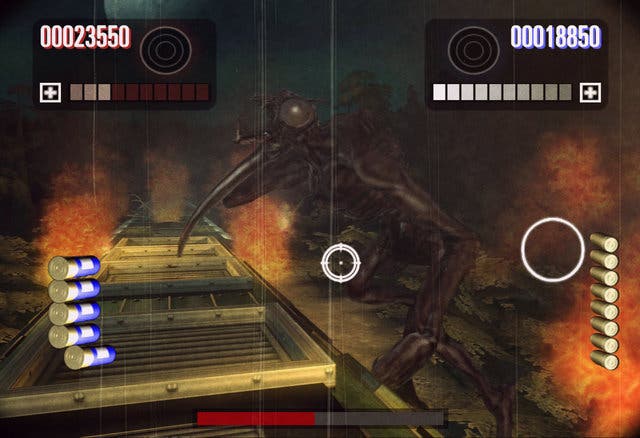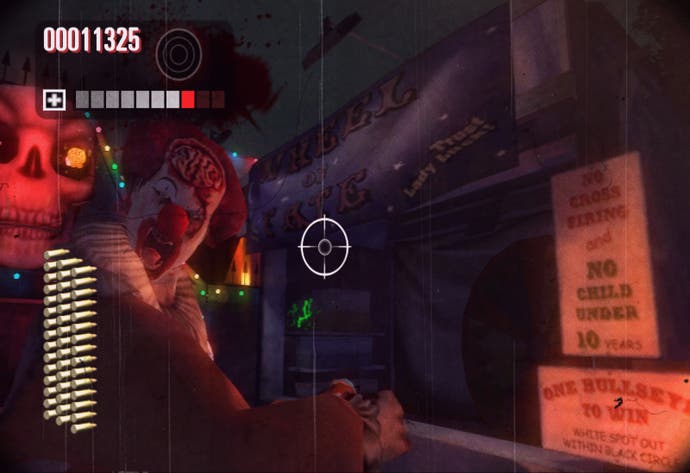The House of the Dead: Overkill
They came for brains. You'll give them bullets.
Rather than eking more out of a short game by ramping up the challenge (and so the frustration for the non-hardcore), Headstrong has surprisingly decided to make the Story Mode a pushover. It's fairly forgiving, with infinite continues - but every continue costs you half your score. Score earns cash, which buys new guns and upgrades for the game's small but thunderous arsenal, which will take a couple of playthroughs to complete.
Buying continues with points is a great piece of design, simultaneously generous and motivating. You can also choose to add more enemies to any level in Story Mode to add variety, challenge and scoring opportunities. But the real carrot - and the answer to any light-gun veterans who might be questioning the game's hardcore credentials by now - is the Director's Cut, unlocked when you complete Story Mode. This is an extended run through the entire game, with new sections, different routes, tougher enemy patterns - and a strict three-continue limit per level. At a stroke, it more than doubles the game's lifespan.
Still not sure that Overkill represents good value? Then there's an achievement system (offering meaningless memorabilia unlocks instead of gamerpoints, but still), three decent mini-games that support four players, both campaigns playable with two of course, and an unlockable dual-wield mode for a single-player if you complete the Director's Cut. For a simple on-rails shooter, it's a handsome package; the only serious omission for a score-attack game is of course online leaderboards, but that's hardly Headstrong's fault.
Overkill is mostly well-tuned, too, although it's here that some small cracks start to show. A Wii remote is not a light-gun, and genre specialists might find its less literal aiming - you're guiding a cross-hair with gestures, rather than looking down your gun - disconcerting. Provided you're not sitting close to a large screen, you'll get used to it. Free look can be turned off (probably a good idea in two-player), as can the crosshair, and the tiny buzz of rumble that tells you you've targeted an enemy or pickup - an excellent innovation, but yes we suppose it is cheating, if you're going to be like that about it.

Interludes where you have to shake the remote to free yourself from a zombie's clutches don't really work - especially if you're using a Wii Blaster or similar gun frame for the remote. Much as we would like to, we can't recommend the official Hand Cannons - beautiful, chunky, gloriously out-sized pieces of moulded plastic they may be, but they're also heavy, off-balance and very uncomfortable to use. Try Venom's more compact Light Blaster instead. You can tip the controller upwards to reload your infinite ammo, but pressing A is faster if you're using a naked remote, which frankly, for an extended session, you will be.
The combo system is very simple but ruthlessly effective and addictive, and quickly becomes your focus once you've started to learn the enemy patterns. It dovetails nicely with the pickups too - health, golden brains (simply collectables for the sake of it), smart-bomb grenades, and the slow-mo pickups for calmly headshotting your way through the most frenzied assault. However, the combo system also exposes one of the game's bigger problems: weapon balance.
All of the guns are gratifying to use, the beefier ones sporting booming sound and camera-shaking recoil. But the SMG and assault rifle, while offering high survivability and the simple pleasure of spraying hails of bullets across walls of reanimated flesh, are simply hopeless from a scoring point of view, because it's too easy to send bullets astray and lose your combo. You're better off with the starting pistol or - especially - the shotgun, which is staggeringly effective, even at range. Too effective, perhaps - and to make matters worse there's an even more devastating automatic shotgun available (for a high price, though).

It's still worth equipping something a little more accurate in your second slot for the bosses. These are the game's other principal flaw - although imaginatively staged and conceived, many of them don't offer much in the way of reward, and their difficulty is all over the place. The first two (the second of which, the Ring-inspired Screamer, is actually a game highlight) are far more difficult than the middle three.
Combined with the occasionally grating script, these moments of weakness and imbalance can cause The House of the Dead: Overkill to feel flat at times. But that's only because they're thrown into stark relief by the rest of the game's frankly amazing quality, attention to detail and largesse: the impeccable presentation and production values, the clever and generous structure, the compelling scoring, the intoxicating flow of the levels. Incredibly for such a simple and strictly limited game, it almost never tries your patience, and it's made with such infectious and irreverent glee and such obvious pride, you can't help but join in.








